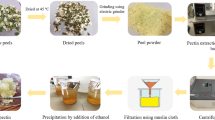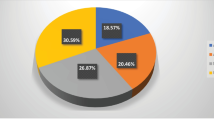Abstract
Pectic oligosaccharides have vital properties that are dependent on their molecular assemblies, such as the degree of esterification (DE) and branched side chains. The molecular structures are affected by the extraction solvents and conditions. In this study, we used pressurized carbon dioxide treatment (CT) as a novel method for pectin extraction from fresh and ripe orange peels and compared the total yield, DE, molecular weight, and monosaccharide compositions of the product obtained with those of products obtained using conventional extraction methods, such as heating with HCl or chelating with sodium hexametaphosphate (SHMP). CT provided a yield of approximately 3.8%, which was less than that of HCl (9.9%/dry weight). However, DE in the CT extract was approximately 94%, which was higher than that of HCl (75%) and SHMP (59%). The molecular weights of pectins in the CT extract appeared to be higher than that of HCl, except at a pressure of 2 MPa. β-Galacturonic acid was the major monosaccharide in pectin extracted by HCl and SHMP, whereas that was decreased in CT extract from fresh oranges. The results showed that extraction with CT contributed to a high DE pectin yield and diverse pectin molecular structures compared to conventional methods, although its application resulted in a lower overall pectin yield. These findings suggest the possibility of manufacturing oligosaccharides with novel properties.






Similar content being viewed by others
Data Availability (data transparency)
All data obtained through this study are presented in this manuscript and can be provided to researchers who demand them.
Code Availability (software application or custom code)
Not applicable.
References
Al-Assaf, S., Phillips, G. O., & Williams, P. A. (2006). Controlling the molecular structure of food hydrocolloids. Food Hydrocolloids, 20(2-3), 369–377.
Albersheim, P., Darvill, A. G., O’Neill, M. A., Schols, H. A., & Voragen, A. G. J. (1996). An hypothesis: The same six polysaccharides are components of the primary cell walls of all higher plants. In J. Visser & A. G. J. Voragen (Eds.), Pectins and pectinases (pp. 47–55). Elsevier Science.
Babbar, N., Van Roy, S., Wijnants, M., Dejonghe, W., Caligiani, A., Sforza, S., et al. (2016). Effect of extraction conditions on the saccharide (neutral and acidic) composition of the crude pectic extract from various agro-industrial residues. Journal of Agricultural and Food Chemistry, 64(1), 268–276.
Bagherian, H., Ashtiani, F. Z., Fouladitajar, A., & Mohtashamy, M. (2011). Comparisons between conventional, microwave- and ultrasound-assisted methods for extraction of pectin from grapefruit. Chemical Engineering and Processing, 50(11-12), 1237–1243.
Bélafi-Bakó, K., Cserjési, P., Beszédes, S., Csanádi, Z., & Hodúr, C. (2012). Berry pectins: Microwave-assisted extraction and rheological properties. Food and Bioprocess Technology, 5, 1100–1105.
Bitter, T., & Muir, H. M. (1962). A modified uronic acid carbazole reaction. Analytical Biochemistry, 4(4), 330–334.
Carpita, N. C., & Gibeaut, D. M. (1993). Structural models of primary cell walls in flowering plants: Consistency of molecular structure with the physical properties of the walls during growth. Plant Journal, 3(1), 1–30.
De Oliveira, C. F., Gurak, P. D., Cladera-Olivera, F., Marczak, L. D. F., & Karwe, M. (2016). Combined effect of high-pressure and conventional heating on pectin extraction from passion fruit peel. Food and Bioprocess Technology, 9(6), 1021–1030.
De Vries, J. A., Voragen, A. G. J., Rombouts, F. M., & Pilnik, W. (1981). Extraction and purification of pectins from alcohol insoluble solids from ripe and unripe apples. Carbohydrate Polymers, 1(2), 117–127.
El-Nawawi, S. A., & Shehata, F. R. (1987). Extraction of pectin from Egyptian orange peel. Factors affecting the extraction. Biological Wastes, 20(4), 281–290.
Fuchigami, M. (1983). Effect of pH on heat degradation of pectin. Journal of Japan Society of Nutrition and Food Sciences, 36(4), 294–298 (in Japanese).
Fuchigami, M. (2007). Heating of vegetables and pectic substances. Journal of Cookery Science of Japan, 40(1), 1–9 (in Japanese).
Hosseini, S. S., Khodaiyan, F., & Yarmand, M. S. (2016). Aqueous extraction of pectin from sour orange peel and its preliminary physicochemical properties. International Journal of Biological Macromolecules, 82, 920–926.
Ichida, J. (2005). Production and physiological functions of apple pectin and pectic oligosaccharides. The Journal of Japan Mibyou System Association, 11(2), 304–308.
Jenkins, D. J. A., Leeds, A. R., Newton, C., & Cummings, J. H. (1975). Effect of pectin, guar gum, and wheat fibre on serum-cholesterol. The Lancet, 305(7916), 1116–1117.
Kar, F., & Arslan, N. (1999). Effect of temperature and concentration on viscosity of orange peel pectin solutions and intrinsic viscosity–molecular weight relationship. Carbohydrate Polymers, 40(4), 277–284.
Kastner, H., Einhorn-Stoll, U., & Senge, B. (2012). Structure formation in sugar containing pectin gels-influence of Ca2+ on the gelation of low-methoxylated pectin at acidic pH. Food Hydrocolloids, 27(1), 42–49.
Kaya, M., Sousa, A. G., Crepeau, M., Srensen, S. O., & Ralet, M. (2014). Characterization of citrus pectin samples extracted under different conditions: Influence of acid type and pH of extraction. Annals of Botany, 114(6), 1319–1326.
Kertesz, Z. I. (1951). The pectic substances. Interscience Publishers.
Kurita, O., Fujiwara, T., & Yamazaki, E. (2008). Characterization of the pectin extracted from citrus peel in the presence of citric acid. Carbohydrate Polymers, 74(3), 725–730.
Liu, L., Cao, J., Huang, J., Cai, Y., & Yao, J. (2010). Extraction of pectins with different degrees of esterification from mulberry branch bark. Bioresource Technology, 101(9), 3268–3273.
Liu, F., Wang, Y., Bi, X., Guo, X., Fu, S., & Liao, X. (2013). Comparison of microbial inactivation and rheological characteristics of mango pulp after high hydrostatic pressure treatment and high temperature short time treatment. Food and Bioprocess Technology, 6, 2675–2684.
Manabe, T. (2001). Pectin. Saiwai Shobo.
Masmoudi, M., Besbes, S., Chaabouni, M., Robert, C., Paquot, M., Blecker, C., & Attia, H. (2008). Optimization of pectin extraction from lemon by-product with acidified date juice using response surface methodology. Carbohydrate Polymers, 74(2), 185–192.
Methacanon, P., Krongsin, J., & Gamonpilas, C. (2014). Pomelo (Citrus maxima) pectin: Effects of extraction parameters and its properties. Food Hydrocolloids, 35, 383–391.
Meyssami, B., Balaban, M. O., & Teixeira, A. A. (1992). Prediction of pH in model systems pressurized with carbon dioxide. Biotechnology Progress, 8(2), 149–154.
Muñoz-Almagro, N., Valadez-Carmona, L., Mendiola, J. A., Ibáñez, E., & Villamiel, M. (2019). Structural characterisation of pectin obtained from cacao pod husk. Comparison of conventional and subcritical water extraction. Carbohydrate Polymers, 217, 69–78.
Muralikrishna, G. (1994). Characterization of pectic polysaccharides from pulse husks. Food Chemistry, 50(1), 87–89.
Ridley, B. L., O'Neill, M. A., & Mohnen, D. (2001). Pectins: Structure, biosynthesis, and oligogalacturonide-related signaling. Phytochemistry, 57(6), 929–967.
Saeed, A. R. (1975). Characterization of pectic substances in mango marc. Journal of Food Science, 40(1), 205–206.
Sayah, M. Y., Chabir, R., Benyahia, H., Kandri, Y. R., Chahdi, F. O., et al. (2016). Yield, esterification degree and molecular weight evaluation of pectins isolated from orange and grapefruit peels under different conditions. PLoS ONE, e0161751.
Sherry, C. L., Kim, S. S., Dilger, R. N., Bauer, L. L., Moon, M. L., Tapping, R. I., Fahey Jr., G. C., Tappenden, K. A., & Freund, G. G. (2010). Sickness behavior induced by endotoxin can be mitigated by the dietary soluble fiber, pectin, through up-regulation of IL-4 and Th2 polarization. Brain, Behavior, and Immunity, 24(4), 631–640.
Shpigelman, A., Kyomugasho, C., Christiaens, S., & Van Loey, A. M. (2015). The effect of high-pressure homogenization on pectin: Importance of pectin source and pH. Food Hydrocolloids, 43, 189–198.
Strydom, D. J. (1994). Chromatographic separation of 1-phenyl-3-methyl-5-pyrazolone-derivatized neutral, acidic and basic aldoses. Journal of Chromatography A, 678(1), 17–23.
Tarutani, T., & Manbe, M. (1963). Study on production of low methoxyl pectin. Journal of Food Science and Technology, 10(8), 316–320.
Vriesmann, L. C., Teófilo, R. F., & Petkowicz, C. L. O. (2011). Optimization of nitric acid-mediated extraction of pectin from cacao pod husks (Theobroma cacao L.) using response surface methodology. Carbohydrate Polymers, 84(4), 1230–1236.
Vriesmann, L. C., Teófilo, R. F., & Petkowicz, C. L. O. (2012). Extraction and characterization of pectin from cacao pod husks (Theobroma cacao L.) with citric acid. LWT - Food Science and Technology, 49(1), 108–116.
Willats, W. G. T., McCartney, L., Mackie, W., & Knox, J. P. (2001). Pectin: Cell biology and prospects for functional analysis. Plant Molecular Biology, 47(1-2), 9–27.
Funding
This work was supported by the Japan Society for the Promotion of Science (17K00818).
Author information
Authors and Affiliations
Corresponding author
Ethics declarations
Conflict of Interest
The authors declare no competing interests.
Additional information
Publisher’s Note
Springer Nature remains neutral with regard to jurisdictional claims in published maps and institutional affiliations.
Rights and permissions
About this article
Cite this article
Tsuru, C., Umada, A., Noma, S. et al. Extraction of Pectin from Satsuma Mandarin Orange Peels by Combining Pressurized Carbon Dioxide and Deionized Water: a Green Chemistry Method. Food Bioprocess Technol 14, 1341–1348 (2021). https://doi.org/10.1007/s11947-021-02644-9
Received:
Accepted:
Published:
Issue Date:
DOI: https://doi.org/10.1007/s11947-021-02644-9




